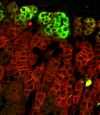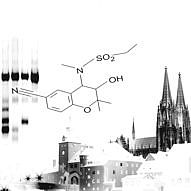
Geförderte Projekte

Bandulik: Bedeutung der zellulären Ionen- und pH-Homöostase für die langfristige Regulation der Aldosteronsekretion in der Nebenniere und für die Pathophysiologie des primären Hyperaldosteronismus
Das Mineralokortikoid Aldosteron ist entscheidend an der Regulation des Salz- und Wasser-Haushalts und damit auch an der Kontrolle des arteriellen Blutdrucks beteiligt. Entsprechend findet man bei 5-10% der Patienten mit Bluthochdruck ursächlich eine inadäquat hohe Aldosteronsynthese in den Glomerulosazellen der Nebennierenrinde, einen sogenannten primären Hyperaldosteronismus (PA). Als genetische Ursache konnten für einen großen Teil dieser Fälle Mutationen in Genen, die für Ionenkanäle und -transporter kodieren, nachgewiesen werden. Die physiologische Stimulation der Aldosteronproduktion durch Angiotensin II oder erhöhtes Plasma-K+ hängt vor allem von einer Depolarisation des Membranpotentials und einem Anstieg der zytosolischen Ca2+-Aktivität der Glomerulosazellen ab. Wesentliche Daten in der Literatur zur Bedeutung dieser Parameter wurden allerdings an akut stimulierten Zellen erhoben. Dagegen findet durch die Expression der PA-assoziierten mutierten Gene eine chronische autonome Stimulation dieses Signalwegs mit unterschiedlich starker Erhöhung der Ca2+-Aktivität statt. Zusätzlich treten dort Veränderungen der pH- und Na+-Homöostase auf, deren spezifischen Auswirkungen auf die Pathophysiologie bisher nicht geklärt sind. Unsere Vorarbeiten zeigen auch bei langfristiger physiologischer Stimulation eine starke Dynamik des Ca2+-Levels und sie deuten auf eine relevante Funktion der zellulären pH-Homöostase für die Regulation der Aldosteronproduktion. Das übergreifende Ziel dieses Vorhabens ist daher, zunächst das komplexe Zusammenspiel zwischen dem zytosolischen Ca2+ als Hauptregulator und der pH- und Na+-Homöostase sowie davon abhängiger Signalwege unter einer chronischen physiologischen Stimulation der Aldosteronsynthese genauer aufzuschlüsseln. Anschließend soll analysiert werden, wie im Vergleich dazu eine Störung dieses regulativen Netzwerkes die Pathophysiologie des PA bestimmt. Insgesamt erhoffen wir uns durch dieses Vorhaben neue Einblicke in die langfristige zelluläre Regulation der Aldosteronsynthese und dadurch ein besseres Verständnis der Pathophysiologie des PA. Damit können möglicherweise auch neue Ziele für die Diagnostik und Therapie dieser Erkrankung identifiziert werden.
The mineralocorticoid aldosterone plays a decisive role in the regulation of the salt and water balance and thus also in the control of arterial blood pressure. Accordingly, in 5-10% of patients with high blood pressure an inadequately high aldosterone synthesis is found in the glomerulosa cells of the adrenal cortex, a so-called primary hyperaldosteronism (PA). Mutations in genes coding for ion channels and transporters have been shown to be the genetic cause of a large proportion of these cases. The physiological stimulation of aldosterone production by angiotensin II or increased plasma K+ depends mainly on depolarization of membrane potential and an increase in cytosolic Ca2+ activity of glomerulosa cells. However, important data in the literature on the significance of these parameters were collected in acutely stimulated cells. In contrast, the expression of PA-associated mutant genes leads to chronic autonomic stimulation of this signaling pathway with varying degrees of increase in Ca2+ activity. In addition, changes in pH and Na+ homeostasis occur there, the specific effects of which on pathophysiology have not yet been clarified. Our preliminary work also shows a strong dynamic of the Ca2+ level during long-term physiological stimulation and points to a relevant function of the cellular pH homeostasis for the regulation of aldosterone production. The overall goal of this project is therefore to break down the complex interaction between the cytosolic Ca2+ as main regulator and the pH- and Na+-homeostasis as well as signal transduction pathways under a chronic physiological stimulation of aldosterone synthesis. Subsequently, it will be analyzed how a disturbance of this regulatory network determines the pathophysiology of PA. Overall, we hope that this project will provide us with new insights into the long-term cellular regulation of aldosterone synthesis and thus a better understanding of the pathophysiology of PA. This may also lead to the identification of new targets for the diagnosis and therapy of this disease.
-->
R. Warth und C. Ziegler: „Proximale tubuläre Signale als Determinanten von Nierenentzündung und Fibrose"
Das Teilprojekt A7 wird in Kooperation mit R. Kleta, UCL, London, und B. Davies, The Welcome Trust Centre for Human Genetics, University of Oxford, durchgeführt.
In den letzten Jahren haben wir die Pathophysiologie von GATM- und EHD1-assoziierten monogenetischen Erkrankungen untersucht, die proximale tubuläre Mitochondrien bzw. die intrazelluläre Vesikeldynamik betreffen. Hier werden wir die Rolle von EHD1 bei der Formung und Dynamik intrazellulärer Membranen und die adaptiven Mechanismen untersuchen, die dem milden Phänotyp von GATM-Knockin-Mäusen zugrunde liegen. Die erwarteten Ergebnisse werden dazu beitragen, die Funktionsprinzipien der Anpassung und Fehlanpassung des proximalen Tubulus zu klären und idealerweise zur Entwicklung eines therapeutischen Ansatzes für das GATM-assoziierte Fanconi-Syndrom führen.
Project A7 of the TRR 374 will be carried out in cooperation with R. Kleta, UCL, London, and B. Davies, The Welcome Trust Centre for Human Genetics, University of Oxford.
In recent years, we have investigated the pathophysiology of GATM- and EHD1-related monogenetic diseases involving proximal tubular mitochondria and intracellular vesicle dynamics, respectively. Here, we will investigate the role of EHD1 in intracellular membrane shaping and dynamics and the adaptive mechanisms underlying the mild phenotype of GATM knockin mice. The expected results will help to elucidate the functional principles of proximal tubule adaptation and maladaptation and ideally lead to the development of a therapeutic approach for GATM-associated Fanconi syndrome.

Warth: Die Mechanismen der Osmo-Sensitivität von Nebennierenrindenzellen und ihre Bedeutung für den adrenalen Phänotyp der Task3-Knockoutmaus
Das Nebennierenrindenhormon Aldosteron bewirkt eine Natriumresorption und Kaliumsekretion in der Niere und ist daher für die Elektrolythomöostase und die langfristige Blutdruckregulation von zentraler Bedeutung. Eine pathologisch gesteigerte Aldosteronsekretion (primärer Aldosteronismus) soll bei 7-20% der Patienten mit arterieller Hypertonie ursächlich sein. Die Aldosteronsekretion selbst muss daher genau kontrolliert und an die Salzaufnahme angepasst sein. Bereits vor drei Jahrzehnten hat man erkannt, dass die Aldosteron-produzierenden Zellen in der Nebenniere in erheblichem Umfang durch die Plasmaosmolarität beeinflusst werden und eine hohe Osmolarität die Aldosteronsekretion hemmt. Überraschenderweise ist das Wissen um die Osmo-Sensitivität der Nebennierenrindenzellen weitgehend in Vergessenheit geraten. Nichtsdestotrotz erscheint es plausibel, dass eine beeinträchtigte Osmo-Sensitivität der Nebenniere zur Entstehung einer autonomen Aldosteronsekretion beitragen und Ursache einer Salz-sensitiven Hypertonie sein kann. Die molekularen Mechanismen und Signalwege der adrenalen Osmorezeption sind jedoch weitgehend unbekannt.
Daher möchten wir die Mechanismen der Osmo- und Salzrezeption in der Nebennierenrinde erforschen und überprüfen, ob der Salz-sensitive Hypertonus der Task3-Kaliumkanalknockoutmaus mit einer pathologischen Osmo-Sensitivität assoziiert ist. Es sollen drei Fragestellungen bearbeitet werden:
1. Wie beeinflussen Osmolaritätsänderungen die elektrischen Eigenschaften und die
zytosolische Calcium-Aktivität der erregbaren Glomerulosazellen?
2. Welchen Einfluss haben Osmolaritätsänderungen auf das adrenokortikale Transkriptom und Proteom?
3. Ist eine defekte Osmorezeption Teil des adrenalen Phänotyps von Task3-Knockoutmäusen?
Durch die Bearbeitung dieser Fragestellungen erhoffen wir uns einen wichtigen
Erkenntnisgewinn hinsichtlich der zellulären Mechanismen und Signalwege der Osmorezeption von Nebennierenrindenzellen und ihrer pathophysiologischen Bedeutung bei der Entstehung einer pathologisch erhöhten Aldosteronsekretion.
The adrenal cortex hormone aldosterone causes sodium resorption and potassium secretion in the kidney and is therefore of central importance for electrolyte homeostasis and long-term blood pressure regulation. Pathologically increased aldosterone secretion (primary aldosteronism) is believed to be the cause in 7-20% of patients with arterial hypertension. Aldosterone secretion itself must therefore be precisely controlled and adapted to salt uptake. Already three decades ago it was recognized that the aldosterone-producing cells in the adrenal gland are strongly influenced by plasma osmolarity and that high osmolarity inhibits aldosterone secretion. It seems likely that impaired adrenal osmo-sensitivity may contribute to the development of autonomic aldosterone secretion and cause salt-sensitive hypertension. However, the molecular mechanisms and signalling pathways of adrenal osmo-reception are largely unknown.
We will investigate the mechanisms of osmo- and salt-reception in the adrenal cortex and test whether the salt-sensitive hypertonus of the Task3 potassium channel knockout mouse is associated with pathological osmo-sensitivity. The follwing questions will be addressed:
1. How do osmolarity changes influence the electrical properties and the cytosolic calcium activity of excitable glomerulosa cells?
2. What influence do osmolarity changes have on the adrenocortical transcriptome and proteome?
3. Is defective osmoreception part of the adrenal phenotype of Task3 knockout mice?
By working on these questions, we hope to achieve an important gain of knowledge regarding the cellular mechanisms and signalling pathways of adremal osmoreception and their significance in the development of primary aldosteronism in humans.

